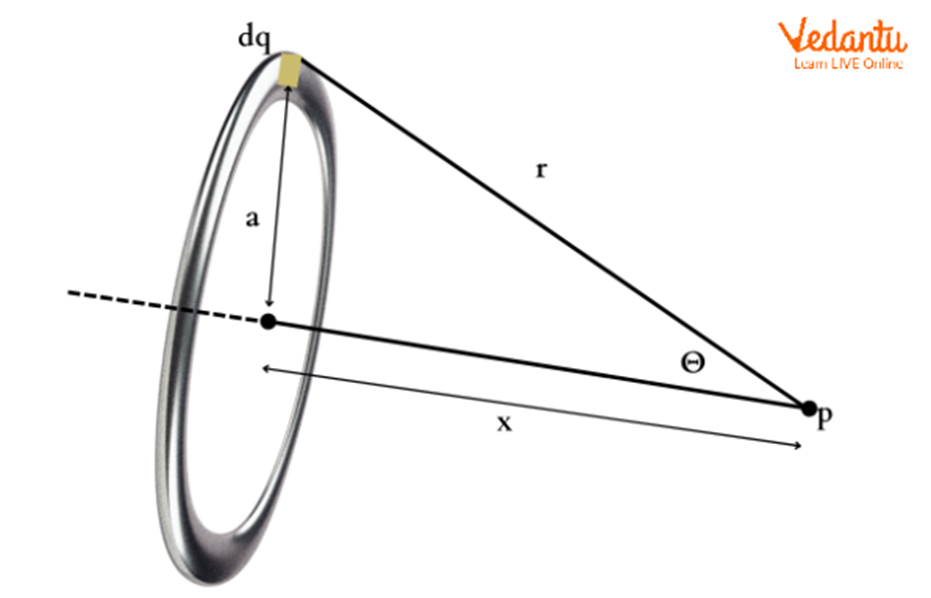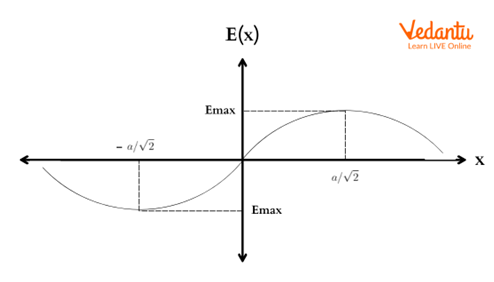




Understanding The Concept of Electric Field Due to a Uniformly Charged Ring
The concept of the electric field due to a uniformly charged ring is crucial in understanding how charged objects influence their surroundings. A charged ring generates an electric field along its axis, which is determined by the charge distribution on the ring. This field has both magnitude and direction, making it essential for studying the interactions of charges. In this article, we will explore the properties of the electric field created by a uniformly charged ring, including its behaviour at various points along the axis. This knowledge helps in analysing the forces exerted on nearby charges, which is vital for applications in JEE Main 2025.
What is the Electric Field Due to a Ring?
When a ring is uniformly charged, it generates an electric field around it. The electric field due to a ring depends on the distribution of charge and the position where it is measured. The field is symmetrical along the axis of the ring and decreases as we move farther from the ring's plane.
Electric Field due to Arc of Ring
An electric field around any charge distribution can be found by creating an element out of infinitesimal point charges. In the case of a uniformly charged ring, the electric field on the axis of a ring, which is uniformly charged, can be found by superimposing the electric fields of an infinitesimal number of charged points. The ring is then treated as an element to derive the Electric Field due to Charged Ring Arc.
Electric Field on The Axis of A Ring Derivation
Consider the following figure as a charged ring whose axis is subjected to an electric field of varying intensity from the centre of the charged ring.

Electric Field at P due to an Infinitesimal Charge dq on a Charged Ring
Let’s now write the Electric Field Due to Ring Derivation to find the electric field along the axis at a distance of x from the centre of the charged ring. Here, $r = \sqrt{x^{2} + a^{2}}$ is the distance of point p from the arc element dq.
According to the principle of superposition, the total electric field at point p (along the axis of the charged ring) is the vector sum of individual electric fields due to all the point charges.
According to Gauss Law, the electric field caused by a single point charge is as follows:
$\overrightarrow{E} = \dfrac {1}{4~\pi ~ \epsilon_0} \times {\dfrac {q}{r^2}}~\hat {r}$
The electric field at point p due to the small point charge dq which is at a radius of a from the centre of the charged ring can be written as:
$\overrightarrow{dE} = \dfrac {1}{4~\pi ~ \epsilon_0} \times {\dfrac {dq}{r^2}}~\hat {r}$
It is important to note that since there is a corresponding piece of point charge on the opposite side of the ring, the y components of the electric field will get nulled throughout.
Hence, only the x component of the electric field will be significant in deriving the total electric field at point p due to a charged ring.
However, we can see that the tiny x component forms an angle Θ at point p along the axis of the charged ring. Hence the electric field equation will be adjusted while considering this angle and hence becomes:
$dE_{x} = \dfrac {1}{4~\pi ~ \epsilon_0} \times {\dfrac {q}{r^2}}~\cos \Theta$
Since the axis forms a right angle with the distance from dq to point p and Θ is unknown, we replace r and $\cos \Theta$ with the known distances x and a. The above equation thus becomes:
$dE_{x} = \dfrac {1}{4~\pi ~ \epsilon_0} \times {\dfrac {dq}{\left({x^2}+{a^2}\right)}}~{\dfrac {x}{\sqrt {\left({x^2}+{a^2}\right)}}}$
Upon simplification,
$dE_{x} = \dfrac {1}{4~\pi ~ \epsilon_0} \times {\dfrac {x~dq}{\left({x^2}+{a^2}\right)^{\dfrac {3}{2}}}}$
Now, by integrating the above equation concerning dq, the total electric field at point p on the axis of a charged ring is given by the following equation:
$E_{x}=\dfrac {1}{4~\pi ~ \epsilon_0} \times {\dfrac {x~Q}{\left({x^2}+{a^2}\right)^{\dfrac {3}{2}}}}$
Note: The above equation holds good only for finding the electric field on any point on the x-axis.
Let us now draw a graph that closely represents the relationship between the electric field along the axis of a charged ring and the distance from the centre of the charged ring.
The electric field is zero at the centre and increases to a maximum on either side of the ring, and then gradually falls back to zero as x approaches infinity. The magnitude of the electric field will be the same due to symmetry and uniformity in the distribution of charge, and the closest graphical representation or the graph of a uniformly charged ring is drawn below:

Electric Field Intensity along the Axis of a Charged Ring
Properties of Electric Field Due to a Uniformly Charged Ring
Symmetry: The electric field is symmetric about the axis of the ring.
Magnitude: The field strength is influenced by the charge, radius of the ring, and the distance of the observation point.
Direction: Along the axis, the field either points towards or away from the ring depending on the sign of the charge.
Applications of Electric Field Due to a Ring
The study of the electric field due to a uniformly charged ring finds applications in various fields, such as:
Designing electric field sensors.
Analysing charge behaviour in particle accelerators.
Understanding electrostatic forces in engineering systems.
Key Points for JEE Exams
When the point p is very far from the centre of the charged ring i.e., x >> a, then the electric field equation is the same as that due to a point charge, as a is very insignificant such that it becomes zero. Hence, the electric field equation when x >> a is
$E_{x} = (Q/4\pi \epsilon _{o}x^{2} )$
When the point p is at the centre of the ring, x = 0. Hence the electric field at the centre of a charged ring is zero which is in conformance with symmetry and uniformity.
The maximum possible electric field intensity can be derived using dE/dx = 0. In this case, it is observed that the maximum electric field strength occurs when $\pm a\sqrt{2}$ and is given by the following equation:
$E_{max} = Q/6\sqrt{3}\pi \epsilon a^{2}$
The magnetic field due to the ring is $B=2\left( R+x \right)\mu lx$.
Conclusion
The charge distribution along the axis of an electrically charged ring will be symmetric on either side of the ring, and, hence, the electric field will be in a direction that is along the axis of the charged ring. The resultant electric field at the centre of the ring will be zero, and it will increase to a maximum at a distance of $a/\sqrt{2}$ on either side of the charged ring. Then, at an infinite distance from the centre, the electric field becomes zero again.
JEE Main 2025 Subject-Wise Important Chapters
The JEE Main 2025 subject-wise important chapters provide a focused strategy for Chemistry, Physics, and Maths. These chapters help students prioritise their preparation, ensuring they cover high-weightage topics for better performance in the exam.
Check Other Important Links for JEE Main 2025
JEE 2025 needs well-structured study materials. Here are some valuable resources to help you plan your preparation and practice efficiently.
FAQs on Electric Field Due to Uniformly Charged Ring for JEE Main 2025 - Formula and Derivation
1. Does a ring charge behave like a point charge? If so, when does this happen?
Yes. A charged ring will behave like a point charge when the distance from the point p to the centre of the charged ring exceeds the radius of the charge distribution to a greater extent. In that case, the radius is negligible and the charge distribution starts to act as a single point charge i.e., at such a far away distance, a ring charge is perceived as a point charge.
The electric field intensity in such a case will be $ E_{x} = \dfrac {Q}{4~\pi ~ \epsilon _{o}~{x^2}}$.
2. What is a uniformly charged ring?
A uniformly charged ring is the one in which the charge is distributed uniformly along the circumference of the ring. The uniformly charged ring plays an important role in understanding electric field generation.
3. What is the electric field due to a uniformly charged ring?
The electric field due to a uniformly charged ring is calculated at a point along the axis of the ring using the charge distribution and distance from the ring's centre.
4. How is the Electric Field Due To the Ring derived?
The Electric Field Due To the Ring is derived using Coulomb’s law, integrating the contribution of charge elements over the circular ring to find the field at a point along its axis.
5. What is the electric field on the axis of a ring derivation?
The derivation involves breaking the ring into infinitesimal charge elements, calculating their contributions, and integrating these along the circular loop to get the net electric field.
6. How does the electric field due to a charged ring vary with distance?
The electric field due to a charged ring along its axis increases with distance up to a certain point and then decreases beyond it, peaking at a specific point from the ring’s centre.
7. What is the Electric Field At the Centre Of the Ring?
The electric field at the centre of a ring is zero due to symmetry, as the contributions from all parts of the ring cancel out.
8. How do you calculate the electric field due to a uniformly charged ring?
To calculate the electric field due to a uniformly charged ring, use the formula $E = \dfrac{kQz}{(z^2 + R^2)^{3/2}}$, where z is the distance along the axis, Q is the total charge, and R is the radius.
9. What factors affect the electric field due to a ring?
Factors include the total charge on the ring, the radius of the ring, the uniformity of charge distribution, and the distance from the axis where the field is measured.
10. Can you explain the electric field due to a charged ring?
The electric field due to a charged ring is directed along the axis of the ring and depends on the charge distribution and the distance from the point of interest to the ring.
11. What is the significance of the Electric Field At the Centre Of the Ring?
The Electric Field At the Centre Of the Ring being zero highlights the symmetry of the charge distribution, ensuring no net field is generated at the centre.
12. How does the electric field due to a ring differ from that of a point charge?
Unlike a point charge, the electric field due to a ring is zero at the centre and depends on the axis distance, showing varying intensity along the axis rather than radial symmetry.



































